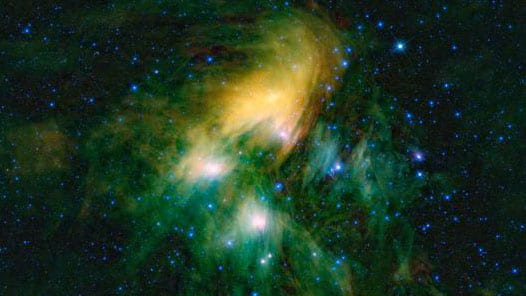By HVN’s Chief Scientist, Professor Richard Mithen

Photo: Pleiades (Matariki) cluster of stars. Courtesy of NASA/JPL-Caltech/UCLA.
At this time of year, the star cluster Matariki will appear in the pre-dawn sky, heralding the start of the month of Pipiri and the Māori New Year. For the first time, Matariki will be a public holiday in Aotearoa New Zealand, to be celebrated on Friday 24 June.[1]
The annual cycle of this star cluster, also known as the Pleiades or the Seven Sisters, has marked the changing year for Indigenous peoples throughout the world. Its appearance and position in the night sky has provided the calendar for festivals to acknowledge the cycles of the seasons and for the sharing of food; a guide to when to sow and when to harvest; and a time for the remembrance of the dead. It is a profound thought that for several thousand years the early farmers of Europe [2], the Indigenous peoples of North and South America [3], and the first Polynesians (amongst others) were all observing the traverse of the Matariki star cluster through the night sky; organising their cultural and social lives around its celestial cycle … unaware of others in far-off lands doing the same.
Look as they rise, up rise
Over the line where the sky meets the earth
Pleiades!
Lo! They ascending, come to guide us
Leading us safely, keeping us one
Pleiades
Us teach to be, like you, united
Pawnee ceremonial song[3]
An important part of Matariki is to make food offerings to the stars. Four of the seven stars that are normally visible are particularly connected to food:
Tupuānuku – food grown in the ground
Tupuārangi – food that comes from the sky and trees
Waitā – food from the sea
Waitī – food from freshwater, streams and lakes
We have plenty to offer from the HVN larder to these four stars…
To Tupuānuku we would offer kūmara that has provided nourishment to the peoples of Aotearoa since their first arrival. Professor Clare Wall and her team at the University of Auckland in collaboration with Kaipara Kumara are exploring how the complex carbohydrates in kūmara may help kick-start the development of the gut microbiome in infants and in so doing boost the immune system. The aptly named SUN study brings together expertise in infant nutrition, gut microbiology and immunology from across the HVN programme. The study is currently recruiting infants of about six months of age who are experiencing their first solid foods.
To Tupuārangi we can offer Aotearoa’s unique mono-floral honeys that come from a partnership between introduced honeybees and the native flora. HVN is supporting further research on the health benefits of mānuka honey in a partnership between the University of Otago and Comvita – exploring how this honey may contribute to a healthy digestive system. HVN is also supporting the development of other mono-floral honeys such as those from rewarewa, rata and kāmahi in a collaboration between Plant & Food Research and Te Pumautanga o Te Arawa.
To Waitā we can offer kutāi, and all the nutritional benefits that come with these mussels. Research led by Dr Matt Miller at the Cawthron Institute and Professor Marlena Kruger of Massey University in collaboration with Sanford are providing the evidence from clinical trials of how kutāi can aid joint health.
To Waitī we will offer a plate of fruit, knowing that the fruit harvest depends upon a plentiful supply of fresh water to satisfy the thirst of the bushes and vines. On the HVN plate we will have plenty of kiwifruit, which comes with a much greater understanding of how moderate consumption can aid digestion thanks to several studies undertaken by Professors Nicole Roy and Richard Gearry of Otago University in collaboration with Zespri. Accompanying the kiwi fruit, we will have New Zealand blackcurrants that are high in polyphenols and which are an important ingredient in the food products manufactured by Ārepa that are being used in clinical trials at the University of Auckland and Plant and Food Research concerned with the gut microbiome, cognitive performance as well as on immunity . We will also include in our offering the less familiar boysenberries that are being studied for their effects on the immune system in collaborative projects between Plant & Food Research and Anagenix.
The preparation, cooking and sharing of food at festivals such as Matariki marks the annual cycle of the seasons and gives us a time to pause and remember those who have come before. It is also a time to be grateful for the plentiful produce that the land and waters of Aotearoa provides. The High-Value Nutrition | Ko Ngā Kai Whai Painga programme seeks to help us understand how our foods maintain and promote our physical and mental well-being through many complex and intersecting biochemical and molecular pathways. The programme embraces the most innovative and progressive science advances and is developing new approaches in our understanding of food and health especially in the area of the immune system. I hope that for you this exciting science and new knowledge adds to your appreciation of the delicious food that you will share on Matariki, and in your daily lives, as it does for me.
[1] The timing of Matariki depend on several factors, and is different between iwi. The Matariki Advisory committee have provided recommendation of the dates for the next 30 years for the one day Matariki public holiday, and explained the methodology behind the selection of these dates: https://www.mbie.govt.nz/assets/matariki-dates-2022-to-2052-matariki-advisory-group.pdf
[2] The pre-Christian festival of Samhain marked the beginning of winter when the Pleiaides was at its highest point in the night sky. The festival is now celebrated as All Souls Day and Halloween, combining remembrance for the dead and the offering of food – whether it is through the provision of Soul cakes or by ‘Trick and Treating’.
[3] Ceci L (1978) Watchers of the Pleiades Ethnohistory 25 301-317: https://www.jstor.org/stable/481683